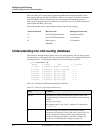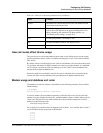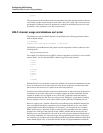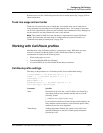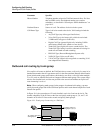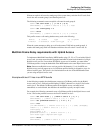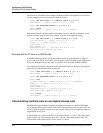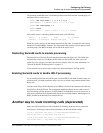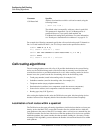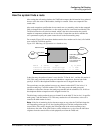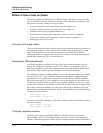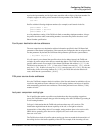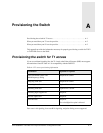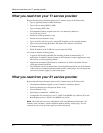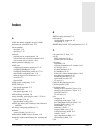
19-10 Preliminary May 9, 2000 APX 8000/MAX TNT/DSLTNT Physical Interface Configuration Guide
Configuring Call Routing
Call routing algorithms
For example, the following commands specify that calls received on the tenth T1 channel on
line 1 of a card installed in shelf 1, slot 22 is always routed to the specified host device:
admin>
read t1 {1 2 1}
T1/{ shelf-1 slot-22 1 } read
admin>
set line channel 10 call-route-info = { 1 7 12 }
admin> write
T1/{ shelf-1 slot-22 1 } written
Call routing algorithms
The call-routing database starts with a list of all possible destinations in the system. During
active use, the TAOS unit keeps track of the devices that are currently in use and does not
consider those devices as possible destinations for a call. After removing entries for devices
that are in use, the system sorts the list of remaining devices in the following order:
• Trunk group number (sorted in descending order; for example, 9–4)
• Subaddress number (sorted in descending order; for example, 9–1)
• Telephone number (empty telephone numbers last)
• Destination device address (zero components sorted after nonzero components)
• Source device address (zero components sorted after nonzero components)
• Routing type (Any-Call-Type last)
After sorting the database in this order, the TAOS unit sorts again, this time placing devices
that have been used less frequently ahead of those that have been used more frequently.
Localization of call routes within a quadrant
The TAOS unit uses the same call-routing algorithms as similar devices that have a lower port
density, such as the MAX TNT, except that it searches first for available devices within the
same quadrant as the source of the call. For example, when a call arrives on a network line, the
TAOS unit searches first for host-side devices within the quadrant. If no devices are available
within the quadrant, the system searches the other quadrants looking for a free entry. To take
advantage of this algorithm, you must balance the number of network and host devices within
each quadrant.
Parameter Specifies
Call-Route-Info
Address of an interface to which a call can be routed, using the
following format:
{ shelf slot item }
The default value is nonspecific, with zero values in each field.
This parameter is deprecated. Use of Call-Route profiles is
preferred. However, if you specify both methods, the
Call-Route-Info setting takes precedence. For more information,
see “Fourth pass: destination device addresses” on page 19-13.



